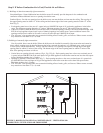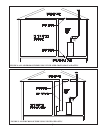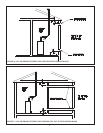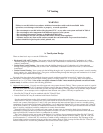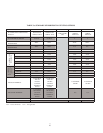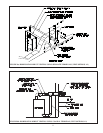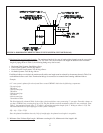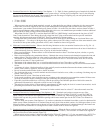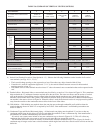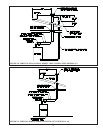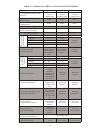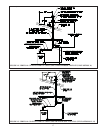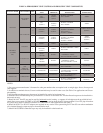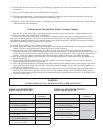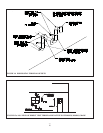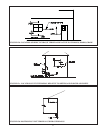
14
14
TABLE 3b: SUMMARY OF VERTICAL VENTING OPTIONS
VENT OPTION # 678910
CLASSIFICATION USED IN THIS
MANUAL
VERTICAL
DIRECT VENT
VERTICAL
DIRECT VENT
(RESERVED
FOR FUTURE
USE)
VERTICAL
DIRECT
EXHAUST
VERTICAL
DIRECT
EXHAUST
ILLUSTRATED IN FIGURE 10 10 11 11
VENT PIPE STRUCTURE
PENETRATION
ROOF ROOF ROOF ROOF
AIR INTAKE PIPE STRUCTURE
PENETRATION
ROOF OR WALL ROOF OR WALL N.A. N.A.
VENT PIPE SIZE 3” 4” 3” 4”
AIR INTAKE PIPE SIZE 4” 4” N.A. N.A.
MAXIMUM VENT
PIPE LENGTH
CWD060 - CWD138 47 FT
47 FT 47 FT 47 FT
CWD165 27 FT
47 FT 27 FT 47 FT
CWD193 17 FT
47 FT 17 FT 47 FT
CWD220 N.R.
47 FT N.R. 47 FT
CWD245 N.R.
47 FT N.R. 47 FT
MAXIMUM
INTAKE PIPE
LENGTH
CWD060 - CWD138 52 FT 50 FT N.A. N.A.
CWD165 32 FT 50 FT N.A. N.A.
CWD193 22 FT 50 FT N.A. N.A.
CWD220 N.R. 50 FT N.A. N.A.
CWD245 N.R.
50 FT N.A. N.A.
EXHAUST TERMINAL BY VENT SYSTEM MANUFACTURER. SAME DIAMETER AS VENT SYSTEM. SEE TABLE 4.
AIR INTAKE TERMINAL
(ROOF PENETRATION)
4” 180 ELBOW 4” 180 ELBOW N.A. N.A.
AIR INTAKE TERMINAL
(WALL PENETRATION)
4” 90 ELBOW 4” 90 ELBOW N.A. N.A.
VENT MATERIAL APPROVED VENT SYSTEM SHOWN IN TABLE 4
AIR INTAKE MATERIAL GALVANIZED OR PVC N.A. N.A.
“N.R” - Not recommended “N.A.” - Not applicable
8) Vertical Vent Terminal Locations (Vent Options 6 - 13) - Observe the following limitations on the location of all vertical
vent terminals (see Figs. 10, 11, 12, 13):
• The lowest discharge opening on the cap must be at least 2 feet above any object located within 10 feet.
• If outside air is used for combustion (Options 6-7, 11-13), the vertical distance between vent and air inlet terminal
openings must be at least 12”.
• The bottom of the air inlet terminal must be at least 12” above the normal snow accumulation that can be expected on the
roof.
9) Terminal offsets - Horizontal elbow or tee terminals may be offset by as much as 5 ft as shown in Figure 14. This sometimes
helps maintain the 12” minimum clearance required above the snow line. The extra two elbows and the section of vertical
pipe on the outside of the building must be counted when checking that the maximum vent / intake pipe length is not
exceeded. On horizontal direct vent systems, both terminals must be offset by the same amount so that their relationship to
one another is the same as shown in Figure 8a. When this offset is used, the horizontal section of vent pipe must be pitched
away from the outside so that condensate cannot collect in the lower offset elbow.
10) Wall thimbles – Wall thimbles are required where the vent pipe passes through combustible walls with less than the
required clearance shown in Table 2 or as required by local codes. Vent manufacturer’s wall thimble part numbers are
shown in Table 4.
11) Condensate Traps and Pitch of Horizontal piping – All horizontal vent piping must be pitched ¼” per foot so that any
condensate which forms in this piping will run towards either the outdoors or into a condensate trap. Vent manufacturer’s
part numbers for suitable condensate traps are shown in Table 4.
All vertical vent systems must include at least one condensate trap as shown in Figures 10-13. This will collect any
condensate that forms in the vent system as well as any rain water that gets around the vent cap.
The maximum allowable vertical run directly off of the boiler without a condensate trap is 7.5 ft (Figure 16). Install a
condensate trap in longer vertical runs so that condensate which might form in this fi rst vertical section will not run into the
boiler fan.



